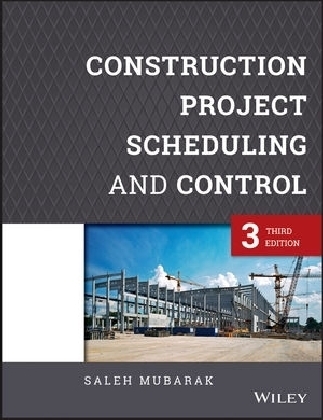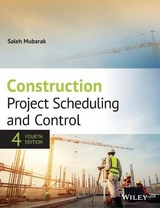
Construction Project Scheduling and Control
John Wiley & Sons Inc (Verlag)
978-1-118-84600-1 (ISBN)
- Titel erscheint in neuer Auflage
- Artikel merken
Bad scheduling can doom a construction project from the start Construction Project Scheduling and Control provides a comprehensive examination of the analytical methods used to devise a reasonable, efficient, and successful schedule for construction projects of all sizes. This updated third edition contains new information on building image modeling (BIM) and its relationship to project scheduling and control, as well as thorough coverage of the latest developments in the field. Written by a career construction professional, this informative text introduces students to new concepts in CPM scheduling, including the author's own Dynamic Minimum Lag technique. The expanded glossary and acronym list facilitate complete understanding, and the numerous solved and unsolved problems help students test their knowledge and apply critical thinking to issues in construction scheduling. A complete instructor's manual provides solutions to all problems in the book, test questions for each chapter, and additional exam questions for more comprehensive testing.
The entire success of a construction process hinges on an efficient, well-thought out schedule, which is strictly defined while allowing for inevitable delays and changes. This book helps students learn the processes, tools, and techniques used to make projects run smoothly, with expert guidance toward the realities of this complex function. * Discover realistic scheduling solutions and cutting edge methods * Learn the duties, responsibilities, and techniques of project control * Get up to date on the latest in sustainability, BIM, and lean construction * Explore the software tools that help coordinate scheduling Scheduling encompasses everything from staff requirements and equipment needs to materials delivery and inspections, requiring a deep understanding of the process. For the student interested in construction management, Construction Project Scheduling and Control is an informative text on the field's current best practices.
SALEH MUBARAK, PD, is an independent consultant in the field of construction project management, based in Tampa, Florida, focusing on training, writing, public speaking, and consulting. He is a former professor at a number of universities and an active member of PMI and AACE International. He served on the PMI committee that created the professional scheduler certification exam, PSP. He has more than 25 years of diversified and international experience including academia and industry; private and public sectors. He is also the author of How to Estimate with RSMeans Data, published by Wiley.
Preface xiii Preface to the First Edition xv Chapter 1 Introduction 1 Planning and Scheduling 2 Project Control 6 Why Schedule Projects? 6 The Scheduler 9 Scheduling and Project Management 10 Chapter 1 Exercises 10 Chapter 2 Bar (Gantt) Charts 13 Definition and Introduction 14 Advantages of Bar Charts 17 Disadvantages of Bar Charts 17 Chapter 2 Exercises 18 Chapter 3 Basic Networks 21 Definition and Introduction 22 Arrow Networks 22 Node Networks 29 Lags and Leads Recommendations for Proper Node Diagram Drawing Comparison of Arrow and Node Networks 35 Networks versus Bar Charts 36 Time-Scaled Logic Diagrams 37 Chapter 3 Exercises 38 Chapter 4 The Critical Path Method (CPM) 43 Introduction 44 Steps Required to Schedule a Project 45 Supplemental Steps 50 Resource Allocation and Leveling 52 Beginning-of-Day or End-of-Day Convention 54 The CPM Explained through Examples 54 Definition Free Float Lags and Leads into CPM Networks Float Discussion Project Schedule Health Check Logic and Constraints 75 Chapter 4 Exercises 76 Chapter 5 Precedence Networks 83 Definition and Introduction 84 The Four Types of Relationships 87 The Percent Complete Approach 88 Fast-Track Projects 89 A Parallel Predecessor? 90 CPM Calculations for Precedence Diagrams 91 The Simplistic Approach Alternative Approaches The Detailed Approach Final Discussion 106 Chapter 5 Exercises 107 Chapter 6 Resource Allocation and Resource Leveling 111 Introduction 112 The Three Categories of Resources 112 What Is Resource Allocation? 113 Resource Leveling 113 Multi-project Resource Leveling Assigning Budgets in Computer Scheduling Programs Leveling Resource in a Project Through Examples Resource Leveling from the General Contractor's Perspective Workspace as a Resource Materials Management 133 Chapter 6 Exercises 135 Chapter 7 Schedule Updating and Project Control 139 Introduction 140 The Need for Schedule Updating 140 Project Control Defined 140 Schedule Updating 141 Steps for Updating a Schedule Project Control 165 Measuring Work Progress Earned Value Analysis Chapter 7 Exercises 184 Chapter 8 Schedule Compression and Time-Cost Trade-Off 189 Introduction 190 Setting Priorities 191 Accelerating a Project 191 How Does Accelerating a Project Work? Direct and Indirect Costs 199 Recovery Schedules 205 Accelerating Projects Using Computers 211 Potential Issues with Uncoordinated Project Acceleration 212 Optimum Project Scheduling 212 Chapter 8 Exercises 217 Chapter 9 Reports and Presentations 221 Introduction 222 The Difference between Reports and Presentations 226 Skills Necessary for Giving Good Presentations 228 The Power of Presentation 229 Reviewing Reports before and after Printing 231 General Tips on Printing Reports 231 Summary Reports 232 Paper or Electronic Reports? 233 E-Reports 235 Communications in the International Environment 236 Chapter 9 Exercises 237 Chapter 10 Scheduling as Part of the Project Management Effort 241 Introduction 242 Scheduling and Estimating 242 Estimating and Accounting 249 Scheduling and Accounting 250 Scheduling and Change Orders 251 Paperless Project Management 251 Procurement Management 252 Management of Submittals 253 The Master Schedule and Subschedules 255 Multiproject Management 256 Time Contingency and Management Options 257 Chapter 10 Exercises 260 Chapter 11 Other Scheduling Methods 263 Introduction 264 Program Evaluation and Review Technique (PERT) 264 Graphical Evaluation and Review Technique (GERT) 280 Linear Scheduling Method (LSM) 281 Chapter 11 Exercises 295 Chapter 12 Dynamic Minimum Lag Relationship 299 Introduction 300 Why DML? 300 Similarity of DML Concept with Linear Scheduling Method (LSM) 301 How Does the DML Work? 302 DML Relationship in the CPM calculations 303 Can the Lag in the DML Relationship Be a Percentage? 304 Conclusion 310 Chapter 12 Exercises 311 Chapter 13 Construction Delay and Other Claims 313 Introduction on delay claims Reasons for claims Types of delays Scheduling mistakes related to delay claims Project documentation Delay claims resolution The importance of CPM schedules in delay claims Methods of Schedule Analysis Case studies in delay claims analysis and resolution Delay and Float Chapter 13 Exercises 334 Chapter 14 Schedule Risk Management 337 Introduction 338 Types of Risk in Construction Projects 339 Schedule Risk Types 341 Definition of Risk Terms 344 Importance of Good Planning for Risk Management 346 Importance of Good CPM Scheduling Practices for Risk Assessment 346 Risk Shifting in Contracts 348 Schedule Risk Management Steps 350 Expected Value 355 Application in Scheduling 357 Examples of Risk Adjustment 358 Conclusion 359 Chapter 14 Exercises 359 Chapter 15 4D Modeling and Scheduling Overview of the Building Information Modeling (BIM) Differences between BIM and CAD Definition and Benefits of 3D Modeling Definition and Benefits of 4D Modeling Steps for Creating 4D Models Case Study Creating and linking the 3D Model Information about Timeliner Tab Creating/Importing Project Schedules Defining Task Types Creating Selection Sets Creating the 4D Model and Project Animation Exporting Snapshots and Animation Using Integrated Systems Lean Construction Chapter 15 Exercises Appendix A Computer Project 361 General Guidelines 361 Cost Loading 366 Updating the Project 368 Change Order 369 Resource Leveling 371 Schedule Compression 371 Schedule Compression 2 373 Delay Claim 1: Unforeseen Conditions 373 Delay Claim 2: Change in Owner s Requirements 374 Appendix B Sample Reports 375 Tabular Reports 375 Graphic Reports 393 Abbreviations 405 Glossary 411 References 433 Bibliography 437 Index 445
| Erscheint lt. Verlag | 28.4.2015 |
|---|---|
| Verlagsort | New York |
| Sprache | englisch |
| Maße | 194 x 241 mm |
| Gewicht | 1060 g |
| Themenwelt | Technik ► Bauwesen |
| Wirtschaft ► Betriebswirtschaft / Management ► Unternehmensführung / Management | |
| ISBN-10 | 1-118-84600-1 / 1118846001 |
| ISBN-13 | 978-1-118-84600-1 / 9781118846001 |
| Zustand | Neuware |
| Informationen gemäß Produktsicherheitsverordnung (GPSR) | |
| Haben Sie eine Frage zum Produkt? |
aus dem Bereich



